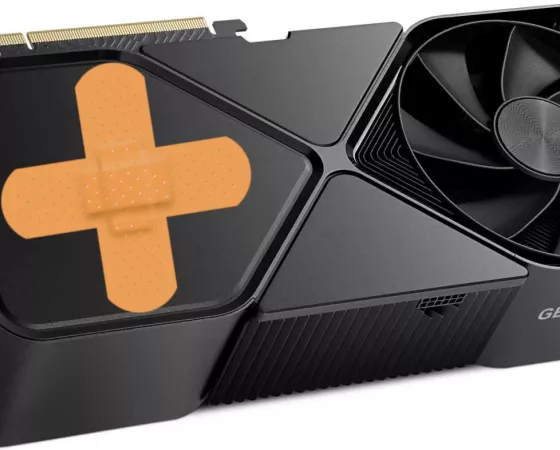Is the Dictionary Done For?
Read more of this story at Slashdot.
Read more of this story at Slashdot.
Read more of this story at Slashdot.
 NVIDIA a publié, il y a quelques jours ses pilotes GeForce Game Ready 591.59. David vous avait fait une présentation de ces derniers pilotes GeForce Game Ready, avec les choses à en attendre. Toutefois, il persiste des bugs (introduits avec ?) qu'il a fallu éradiquer, et le hotfix était un bon moyen...
NVIDIA a publié, il y a quelques jours ses pilotes GeForce Game Ready 591.59. David vous avait fait une présentation de ces derniers pilotes GeForce Game Ready, avec les choses à en attendre. Toutefois, il persiste des bugs (introduits avec ?) qu'il a fallu éradiquer, et le hotfix était un bon moyen...
Read more of this story at Slashdot.
Read more of this story at Slashdot.
Read more of this story at Slashdot.
Read more of this story at Slashdot.

Le jeu Bloodstained: Ritual of the Night est offert par le store d'Epic Games, vous avez jusqu'à demain 17 heures, pour effectuer l'ajout ici.Les Igavania sont de retour ! Vous incarnez Miriam, une orpheline marquée par la malédiction d'un alchimiste qui cristallise lentement son corps. Pour se sauver, et sauver l'humanité, elle doit se frayer un chemin à travers le château pour vaincre l'invocateur, Gebel. […]
Lire la suite
Read more of this story at Slashdot.

Bloodstained: Ritual of the Night est un jeu de rôle gothique d’horreur et d’action à défilement horizontal qui se déroule dans l’Angleterre du 18ᵉ siècle. Une force paranormale a fait surgir un château infesté de démons, révélant avec lui des éclats de cristal imprégnés d’une puissance magique considérable.
PEGI 12 – Audio en Anglais et Texte en Français – Windows
Retrouvez tous mes bons flans sur Mistermatos.com
Bon Flan : Bloodstained: Ritual of the Night gratuit 🍮 © MiniMachines.net. 2025

Elles n’avaient pas tout à fait disparu mais les voilà de retour en force, ce que j’appelle les configurations minables sont de nouveau bien en vue.

Les configurations minables ce sont ces minimachines qui apparaissent ici et là avec un prix défiant toute concurrence et qui viennent progressivement remplacer les MiniPC que nous croisions jusqu’à la rentrée de septembre. Les algorithmes des plateformes de vente adorent nous cataloguer. A grands coups de cookies, elles dressent un profil de nos goûts et déterminent notre pouvoir d’achat. Aussi, quand nous recherchons un produit dans une certaine tranche de prix, elles s’efforcent de nous en proposer d’autres, encore et encore.
Mais que se passe t-il quand l’offre change, par exemple suite à une augmentation de prix importante ? Un internaute qui a été sur une plateforme de eCommerce en septembre pour chercher un MiniPC à 150€ et qui retourne aujourd’hui sur la même plateforme aura une drôle de surprise. Dans les suggestions mises en avant par le site, il découvrira toujours toute une série de MiniPC de 120 à 150€. Simplement, elle aura considérablement évolué, dans le mauvais sens.

Dans l’offre massivement mise en avant aujourd’hui, des engins que plus personne ne regardait il y a seulement quelques semaines. Des machines sous Celeron, de vieux Athlons et autres configurations équipées de 8 Go de mémoire vive et 128 à 256 Go de stockage. Certains livrés avec un système d’exploitation. D’autres sans.
Dans le lot, on note particulièrement le retour de l’AMD 3020E qui est, avec le 3015E, la puce la plus bas de gamme possible de l’offre AMD compatible avec Windows 11. Le 3020E est sorti en 2020 et propose des performances vraiment ultra-basique. Comptez sur deux cœurs Zen 1 sans multithreads. Une fréquence de 1.2 GHz et un circuit graphique Radeon Vega 3. Cette puce est moitié moins rapide qu’un Intel N150 avec énormément de fonctions en moins pour une consommation équivalente.

Quand on se compare à un Celeron N4020 de 2019…
Intégrée dans des MiniPC avec 8 Go de DDR4 (souvent en monocanal) et un stockage de 128 ou 256 Go, elle se vend pour 120-130€ en ce moment. Soit le tarif des MiniPC Intel N150 16/512 Go en aout. Ce machines poussées en avant par des plateformes comme AliExpress, deviennent pour un non initié le nouveau « bon plan » du moment. Si l’engin sera sans doute fonctionnel, son niveau de performance le classera comme un engin très entrée de gamme. Cette puce était déjà pénible à exploiter sous Windows à sa sortie en 2020, elle sera horrible à utiliser en 2025 et bientôt 2026.

Même chose pour ce MiniPC sous Intel Pentium J3710 de… 2016 ! Lui n’est pas compatible avec Windows 11 mais livré avec en outrepassant les solutions de sécurité de Microsoft. Les performances de ce type de puce sont abyssales. C’est clairement un processeur qui n’a de sens aujourd’hui que pour une exploitation monotache avec un usage industriel sous Linux.
x
Ce type de configuration peut se décliner dans différents scénarios et avec de multiples variations. Toutes se basent cependant sur la même logique. Une puce ancienne remontée du fond de vieux stocks comme des Penitums et Celeron ou ces fameux AMD 3015E et 3020E, qui reprennent du service en ajoutant un peu de mémoire vive et un stockage basique. Pour baisser le prix de l’ensemble, des composants de seconde zone sont embarqués à bord.
Le tout est emballé dans des boitiers à la connectique limitée. En général deux paires d’USB Type-A, deux sorties vidéo dans le meilleur des monde, un Ethernet Gigabit et un Jack. Le module sans fil est souvent confié à une solution Wi-Fi5 et Bluetooth 4.2.
Je ne dis pas que ces configurations minables n’ont aucun intérêt, j’utilise toujours un MiniPC fanless équipé d’un Celeron avec 8 Go de mémoire vive DDR4 comme petit serveur perso. Mais à moins d’avoir une idée réellement précise et identifiée des usages que l’on veut en faire, ce type d’engin ne sera pas assez performant pour utiliser confortablement un système d’exploitation moderne.
Ne vous faites donc pas berner par ces MiniPC entrée de gamme. Cela n’est pas une solution viable pour un usage courant.
MiniPC : le retour en force des configurations minables © MiniMachines.net. 2025

La direction du Washington Post savait que son nouveau podcast généré par IA produisait de 64 à 84 % d’actus erronées, malgré un algorithme dédié. En proie à une perte de centaines de milliers d’abonnés, notamment depuis l’élection de Donald Trump et le recentrage droitier voulu par Jeff Bezos, sa direction assume de vouloir continuer à l’expérimenter.
Le 10 décembre dernier, Bailey Kattleman, la responsable produit et conception au Washington Post, expliquait à Digiday vouloir « attirer les jeunes auditeurs » avec une nouvelle offre de podcasts personnalisés grâce à l’IA.
L’objectif de Your Personal Podcat est de leur permettre de choisir leurs sujets préférés, afin de « façonner leur propre briefing, sélectionner leurs sujets, définir leur durée, choisir leurs animateurs et bientôt même poser des questions à l’aide de notre technologie Ask The Post AI », et proposer un nouveau moyen d’accéder à ses articles, de manière « flexible » et « attrayante ».

Interrogée par NPR, Bailey Kattleman évoquait une « expérience d’information audio alimentée par l’IA », qui permettrait « bientôt » aux auditeurs d’interagir avec le podcast. Kattleman précisait à Digiday que son équipe voulait permettre à ses utilisateurs de mettre le podcast en pause et de poser des questions à voix haute, afin d’obtenir davantage de contexte, de clarifier certains points ou de répondre à des questions.
Le podcast a été développé dans le cadre d’un accord pluriannuel entre le Washington Post et Eleven Labs, une société spécialisée dans les logiciels de génération vocale par IA, qui crée des versions audio d’articles pour des éditeurs tels que le Post, Time et The Atlantic.
Mais plutôt que de proposer une version audio des articles, l’IA associée au podcast sélectionne et assemble « environ quatre actualités principales », en fonction de l’historique de lecture et d’écoute de l’utilisateur et des sujets qu’il suit dans l’application.
La durée du podcast étant limitée à 8 minutes seulement, chaque actualité se retrouve dès lors résumée en moins de deux minutes, quelle que soit la longueur de l’article associé.
Un peu à la manière de NotebookLM, deux « animateurs IA » se relaient pour résumer les articles tout en « en discutant dans un ton plus décontracté que lors d’un briefing d’information classique », soulignait Digiday. L’article évoquait également l’engouement de certains médias pour les vidéos courtes façon TikTok, et ceux recourant à l’IA pour sélectionner et résumer des fils d’actus personnalisés.
Bailey Kattleman expliquait à Digiday que le projet, initié environ six mois plus tôt, était arrivé sans trop de difficultés « au stade de la démonstration », mais que le plus compliqué avait été de « perfectionner le podcast ».
Elle précisait que l’équipe produit du Post avait également créé un « algorithme de notation interne pour déterminer la qualité du podcast, en tenant compte de l’exactitude des faits, du ton des voix générées par l’IA, de l’attribution et du caractère engageant du podcast ».
NPR relevait cela dit qu’une note conseille aux auditeurs de l’application de « vérifier les informations » en comparant le podcast avec ses sources. Un avertissement figurant également en exergue des articles, eux aussi générés par IA, qui ont récemment valu à Politico d’être accusé de violer ses propres règles d’éthique éditoriale journalistique en publiant des articles « hallucinant » de fausses informations.
Las : le 11 décembre, soit 48 heures seulement après le lancement du podcast personnalisé généré par IA, le canal Slack du WaPo était submergé par des dizaines de messages de journalistes remettant en question la manière dont cette fonctionnalité avait été rendue publique par la direction, rapporte Status. Certains allaient jusqu’à le qualifier de « désastre » : « Quelles sont les mesures mises en place pour garantir l’exactitude de ce podcast ? », demandait par exemple un membre du personnel.
 Souvent, au lancement d'une nouvelle génération de cartes graphiques, les fabricants tentent de faire bonne impression en proposant des designs et refroidisseurs améliorés par rapport aux séries précédentes. Du côté de GIGABYTE, le lancement des GeForce RTX 50 avait été l'occasion de promouvoir des...
Souvent, au lancement d'une nouvelle génération de cartes graphiques, les fabricants tentent de faire bonne impression en proposant des designs et refroidisseurs améliorés par rapport aux séries précédentes. Du côté de GIGABYTE, le lancement des GeForce RTX 50 avait été l'occasion de promouvoir des...
Read more of this story at Slashdot.
Read more of this story at Slashdot.